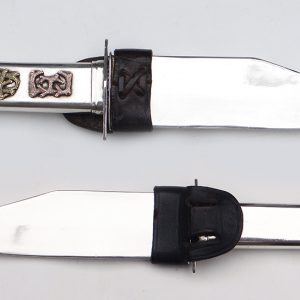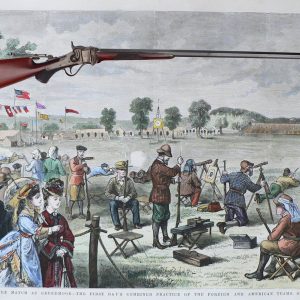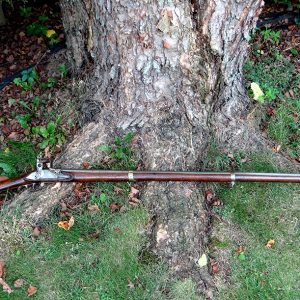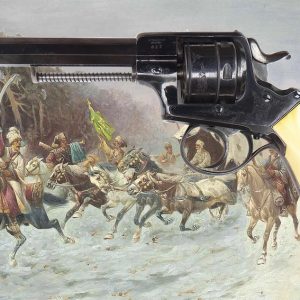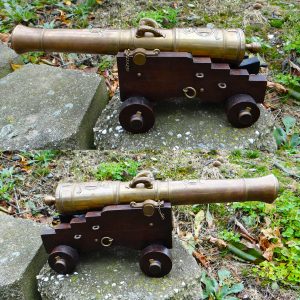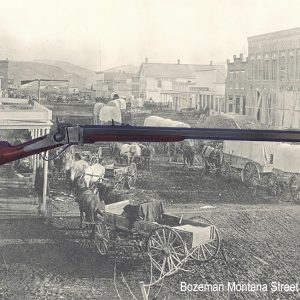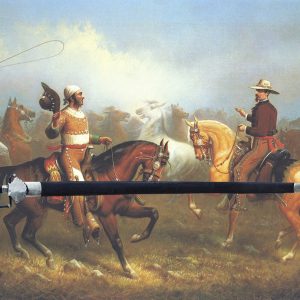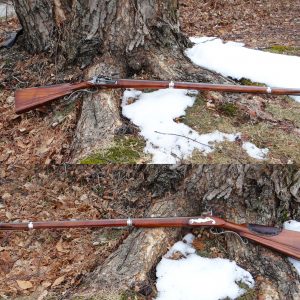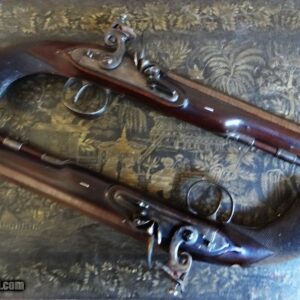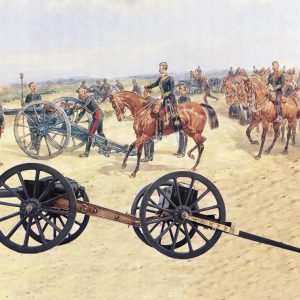This exceptional American, antique 1860 – 1885, silver handled, gold mounted, heavy bladed Bowie knife is reminiscent of the fighting knives built by San Francisco knife makers for those who could afford them during the California Gold Rush period. This knife was specially designed and built for a wealthy and/or prominent individual who anticipated being in perilous situations. It makes one immediately think of flamboyant characters of the American Frontier and Mississippi riverboat gamblers.
While most deluxe Bowies built with precious metals were intended for dress and presentation purposes, this knife features a compact, heavy, and wide blade by the famous maker ‘Geo. Westenholm, Sheffield’ and was designed for self protection in dangerous situations.
This beautiful knife features a heavy solid silver hilt and crossguard. The pommel is set with a fine garnet stone. The right side of the grip bears three, substantial, applied 14k multicolor gold (green, yellow, and rose gold) chased and engraved owner’s initials formed in a naturalistic ‘tree-branch’ style popular in the Victorian period and most often associated with large multi-color solid gold cased pocket watches, heavy signet rings, and gold headed canes. The left side of the grip bears an applied silver coin, perhaps a good luck token.
The original scabbard is heavily silver plated brass. We believe choice of brass for the scabbard was a matter of practicality given the weapon’s heavy blade and serious purpose. The scabbard (pure sterling) retains its original leather ‘frog’ which has rather narrow slots indicating perhaps a narrow belt or strap was employed for some kind of concealed carrying.
CONDITION: This most impressive knife is in excellent original condition. The blade bears its original factory polish and very sharp edge. The hilt is excellent with with all contours and engraving crisp and a lovely light patina. The scabbard is excellent with some handling marks and a dent at the tip.
This is an especially fine piece for any public or private collection of Western Americana. We have enjoyed ownership of this item for many years wondering who it might have been built for and what stories it might tell.
DIMENSIONS: overall length 10 1/4″, blade 5 3/4″ x 1 1/4″ x 3/16″
Price: $750.00 – SOLD
One of the icons in the collecting of original Sharps rifles is the Model 1874, Hartford production ‘NUMBER ONE SHARPS CREEDMOOR’ rifle. These deluxe long range target rifles were built by the Sharps Rifle Manufacturing Company, Hartford, Connecticut in 1874 – 1875 and were intended to compete in international target competitions at ranges of 800 to 1000 yards.
The Sharps ‘Creedmoor’ was designed as a consequence of a letter sent to the New York Herald and published on Nov. 22,1873 titled, “Challenge to the Riflemen of America from the Riflemen of Ireland”. The Irish rifle team had recently won a long range championship rifle match against the English team and thought themselves the World Champion Long Range Rifle Shooting Champions of the World. During the latter part of the 19th century and into the early 20th century organized target matches were some of the most important sporting events in the USA. The American National Rifle Association founded in 1871 supervised the building of a shooting range in Creedmoor, Long Island, NY and a New York rifle club accepted the Irish challenge. The rifle match was to be conducted at 800, 900, and 1000 yard ranges. The paper target for these matches had a 3 foot square ‘bullseye’ which at 1000 yds. looked like the head of a pin to the shooter. The Irish and English rifle teams claimed the finest target rifles in the world were the deluxe muzzle loading match rifles built in London, England by Whitworth and other famous makers which could not possibly be equaled by breechloaders.
The Americans didn’t agree. The Sharps Rifle Manufacturing Company in Hartford Connecticut designed a special long range target rifle using their Model 1874 action to compete in the international target match. According to existing British and Irish rules the rifles could not exceed ten pounds in weight, had to have open iron sights, single triggers (no set or ‘hair’ triggers allowed), and the shooting had to be done without any rifle rest or sling. Sharps designed and built 134 ‘Number 1 Creedmoor Rifles’ the first of which which were ready by the end of March, 1874. The ‘No.1 Sharps Creedmoor’ rifle had a 32″ barrel, was in .44-90-2 5/8″ Sharps caliber, had a single trigger, and weighed 10 lbs. Special long range vernier elevation and wind gauge sights were designed for these rifles. The sights for each rifle were put up in Moroccan leather cases lined in silk/velvet with Sharps Rifle Manufacturing Co. markings inside the lid.
The American six man team won the long range match held at Creedmoor, NY on Sept. 26, 1874 claiming the prize and title of ,”World Champion Rifle Shots”. In the following years American teams continued to win to the degree that the British would not let them compete in English matches but did allow them to ‘coach’ the Irish team, and the Irish team consistently won their matches.
This rare and important ‘Sharps No.1 Creedmoor’ rifle, accompanied by its original cased Creedmoor sights, was shipped from the Sharps factory to their agents ‘J. P. Moore & Sons’, New York City on April 1, 1874 being one of the first ‘Creedmoor’ rifles produced. It is most likely this rifle was actually used in the first Creedmoor match in Sept.,1874.
This rare Sharps ‘No.1 Creedmoor’ is in excellent original condition and is accompanied by its original sights in their factory original leather covered case (an original Sharps Hartford Creedmoor sight case is a great rarity). This rifle is also accompanied by factory serial number authentication from William Peace including a copy of the actual Sharps factory ledger entry for this rifle. William Peace was one of the premier Sharps collectors of the 1960s and owned the original Sharps factory records at that time.
CONDITION: This original No.1 Creedmoor retains 95%+ original blue on its full octagon barrel. The bore and mechanical functions are excellent. The frame and lock retain 85% original Hartford-Sharps muted color casehardening. Most of the screws retain their original blued finish. All serial numbers match and the rear sight base is numbered to the rifle. The sights are in excellent condition. The original sight case is in excellent condition with a bit of handling wear. The semi-deluxe walnut stocks are in excellent condition retaining 95%+ original finish with a few very light handling marks.
Provenance: This Sharps Creedmoor was acquired from Dewey Bryant, Gray Maine, in the Fall of 1969. Dewey was well known as an early collector of fine single shot target rifles and Winchester repeaters. Dewey said that he had purchased this Creedmoor in Maine in 1935. This rifle has been in a private collection since 1969.
Price: $21,500.00 – SOLD
An excellent original example of a very rarely seen Spanish Flintlock Infantry musket of the Model 1803 as improved in 1808.
In their fine reference book – “Spanish Military Weapons in Colonial America ,1700- 1821”, S.B. Brinkerhoff & P.A. Chamberlain, Stackpole Books, 1972, page 37, plate 36 – the authors state in regard to the 1791 Spanish musket, 1808 variation; “Few specimens of this variation are known, but it appears that quite a number were produced.”
In the Spanish colonies of Mexico, Texas, New Mexico, Arizona, California, and Florida muskets of this pattern would have been frontline infantry arms which saw very heavy usage in situations and climates not favorable to the survival of iron and steel implements. They would also have been frontline weapons during the Napoleonic wars in Europe where Spanish armies fought on both sides and Spain was ravaged by both French and British armies in the course of that long conflict. In addition they would have been frontline arms during Mexico’s War Of Independence in 1821. Muskets which survived these conflicts through capture would have continued in service in Mexico and the Southwest. It is not unlikely that some muskets of this pattern served at the battle of the Alamo. Surviving muskets of the Napoleonic wars in Spain became obsolete in 1815 and likely were issued to militia and finally consigned to the African trade. Given their history it becomes apparent why examples of this pattern musket are seldom encountered.
This musket has a 42 3/4″ barrel, 1/4 octagon, in .72 caliber., overall length 58″. The 1808 improvement features a French pattern lock with internal mainspring. However the lockplate has an opening through the lockplate behind the cock. There are half and full cock notches cut on the back edge of the cock which are engaged by a sear protruding through the lockplate in the usual Spanish style. Despite this the tumbler retains its notches inside the lock and the sear also engages these interior notches. The result is a tumbler and sear twice as robust as found on a normal flintlock or miquelet lock. This feature may have been needed given severe conditions where these muskets saw service. This musket has a full complement of Spanish military markings including clear inspectors/ issue marks on the stock. One of these stampings is a “P.D.L.” in a circle on the right side of the butt. This mark is also seen on a Model 1803 Spanish musket in the collection of the ‘Arizona State Museum’, Tucson, AZ as illustrated in, “Spanish Military Weapons in Colonial America ,1700- 1821”, pages 36-37, plates 33,34,35.
Somehow this example of the Spanish 1803 infantry musket, 1808 variation, has survived in excellent original condition. The steel barrel, lock, trigger, ram rod, sling swivels, and screws are excellent with natural steel patina with some very light pitting on the lockplate. The barrel bears Spanish military marks, ‘R’, ‘P’, ‘EX’, a mark i can’t make out and a ‘Y’ above the touch hole. The lock has no exterior marks. The musket has all brass mounts which are in excellent condition with attractive golden patina. The rather fancy grade walnut stock is in excellent condition with great color and old/original surface. It bears a number of inspector’s and issue marks on both sides of the butt – please view all detail pictures.
Overall this is a remarkable specimen of a very rare original flintlock military musket with strong American Southwest and California historical association. This great looking musket also can also be associated with Spanish Colonial Mexico, and the Napoleonic wars. This rare original artifact from a most important historical era is most suitable for any private or public collection. It has been in an old private collection for the last thirty years.
Price: $3250.00 – SOLD
An exceptional excellent original example of an early large bore center fire Victorian revolver. This beautiful deluxe engraved example of an Adams Model 1867 Army revolver made under license by the world renowned arms maker Auguste Francotte manufacturer in Liege. They were a maker of revolvers, military arms, and hunting guns of fine quality built in high artisan tradition, founded in 1810 by Joseph-Barthelemy Francotte. Francotte interestingly was originally a musician. Titled families of the tsarist empire were faithful customers and top quality Francotte firearms of several types were appreciated worldwide. The house was managed by the direct descendants of the founder until 1972 the most famous representative was Auguste Francotte (1901-1984). The company closed its doors forever in 2002.
This Francotte six shot revolver is .44 Russian caliber with a 6 1/4″ barrel. It operates both double and single action and is equipped with a side rod ejector and spring safety mounted on the right side of the frame. This heavy military type revolver is based on the British Adams Model 1867 Army revolver. In the 1860s Auguste Francotte obtained license from Adams to produce revolvers of his design of which this would be a deluxe grade example embellished with ‘banknote’ style engraving. Having been built in .44 Russian caliber one surmises it was specially ordered by one of Francotte’s Imperial Russian customers. However the .44 Russian cartridge was also very popular in a number of countries including Mexico.
Deluxe military type revolvers of this period, 1867 – 1876, were not produced in large numbers and are rare in this excellent original condition.
CONDITION: This revolver retains 97% of its original high polish blued finish with some very minor aging. The bore and mechanical functions are excellent. The Francotte markings are crisp as is the very high quality ‘banknote’ style engraving on the revolver’s frame and cylinder. The hammer, trigger, and spring safety were finished in-the-white and have excellent patina. The screws retain all their original fire-blue finish. This revolver has a beautiful original one piece grip with lovely patina.
This impressive and exceptional revolver showing little if any use, represents the best of its type and would stand out in any high condition collection of 19th century handguns.
NOTE: This antique pistol is being sold purely as a collector’s item. It cannot be shipped to any locations where firearms legislation does not recognize antique arms, such as NYC, NJ, etc. Buyers are fully responsible for abiding by their local firearms regulations. We will not ship outside the USA. For the benefit of foreign buyers we will ship to fully licensed firearms export agent within the USA.
Price: $1750.00 – SOLD
One of the finest quality scale models we have ever encountered, this ‘Admiralty / Board of Ordnance’ quality representation of a British Royal Navy 24 pdr. of 1743, is an example of the best of its type. This fine model was built in 1987 by N.B. Heathecote and is signed on the barrel and the silver plaque on the front of the carriage.
During the 17th and 18th centuries the British Admiralty and Board of Ordnance commissioned exact scale models of proposed warships and naval ordnance. These superb representations in brass, iron, and wood were accurate to the smallest detail and their measurements would be scaled up to construct actual ships, guns, etc.
For most of the 18th century brass cannon barrels (technically naval bronze) were considered the top choice in artillery ashore and afloat. Their disadvantage was they were heavy and expensive to produce. Iron cannon barrels were being introduced, they were lighter in weight and cheaper than brass guns – which mattered more to the British army than the Royal Navy – but were inferior to brass guns in most ways. Therefore the Royal Navy was able to stick with brass guns. In 1722, Colonel John Armstrong took over as Surveyor General of Ordnance. Armstrong immediately set about redesigning British ordnance. His aim was to lighten the guns. Unfortunately, this made them even more prone to failure. Over the next two decades the strength of gunpowder had increased, exacerbating the problem, heavier models were tried. They were shown to be inadequate during the early years of war with Spain (1739-1749) prompting another re-design in 1742. Armstrong died in 1742, the new Surveyor General was Thomas Lascelles who oversaw redesigns in 1743 which proved adequate for service in the French & Indian War.
This cannon is an exact model of the ‘Armstrong Pattern’ 24 pdr. introduced in 1743. The brass 24pdr was the second most powerful cannon used aboard ship at the time. It was a powerful and versatile gun mounted aboard 4th rate ships-of-the-line ( 40 t0 64 gun ships) and as second tier armament on ships of 74 or more guns (higher rates).
This beautiful and substantial model follows that tradition in form, construction, and detail. The cannon has a 115 3/4″ heavy brass barrel with 2 1/2″ breech diameter. The barrel is signed by its maker in chiseled relief, “N. B. HEATHCOTE FECIT 1987”, the barrel also features the British Royal crest, and the arms of King George II in bas-relief exhibiting the highest quality chasing and engraving. A pair of cast dolphins are mounted above properly low set barrel trunnions precisely as they appeared on full size naval guns of the period. The barrel is mounted on a mahogany gun carriage featuring all the proper fittings executed in brass. The elevation platform and moveable quoin is present. The modeling quality is exceptional down to the small tenons used to lock gun carriage reinforcing bars. The front of the gun carriage bears a hallmarked sterling silver plaque engraved, “HEAVY 24 Pdr, British 1743, N.B. Heathcote, Hatton, Warwick, Model No. 007”. The obvious great expertise, effort, and artistic ability put into the construction of this model leads one to believe it, and six other cannon, could very likely have been commissioned and built for a special occasion and/or presentation.
It is very interesting to note that a number of 1743 pattern brass Armstrong pattern 24pdr guns were found at the wreck site of HMS ‘Victory’ sunk in the English Channel in 1744. Diver’s underwater photographs clearly show these guns in situ and the form and details of the model match the the guns carried aboard ‘VICTORY’.
This beautiful and impressive model is in excellent original condition.
Dimensions: barrel length 16″, breech diameter 2 1/2″ , bore .75 caliber 93/4″), overall length 16″, width 7″, height 6 7/8″, weight 12 1/4 lbs
Price: $1550.00 – Sold
An exceptional original flintlock 48″ barrel Ketland & Company Trade Gun, circa 1760. The gunmaking company of William Ketland was established in Birmingham, England in the 1745-1750 period and developed a substantial business producing firearms for export to North America. One of their most successful arms was what has come to be known as the, ‘Ketland Trade Gun’. The English needed a special long gun designed to compete with French Indian trade guns in their military and trading confrontations with the French over control of North America ( this military and commercial strife lasted from the 17th century into the latter decades of the 18th century involving all who lived in the region).
These very handsome and well built Ketland guns were relatively light weight long barrel full stock flintlock brass mounted smoothbore pieces of .62 caliber (roughly 20 gauge) with fairly thick walled barrels intended for firing a single ball and/or shot. Those intended primarily for shooting a single ball had rear sights in addition to a rather distinctive silver front sight. Ketland long guns of this type have excellent handling characteristics. They are of a very practical caliber for both hunting and defense. Their sleek form attracted a lot of attention. These guns became so popular as hunting, militia, and trade arms in the American Colonies with both Indians and white colonists that they continued, with minor improvements, being built from around 1750 into the 1830s.
Today, examples of the flintlock ‘Ketland Trade Gun’ in fine original condition are quite difficult to find. They were utility guns intended for hard use in rough country on the edges of ‘civilization’ and they simply got worn out and used up. Remains of these guns have been found in excavations of Indian camps and white forts/settlements up and down the US East Coast and westward across the Allegheny Mountains.
The ‘Ketland Trade Gun’ shown here is one of the truly rare early – circa 1760 – period examples. The first Ketland guns of this type may have been built as early as 1750 and appear to have had three screw locks, see P-282, “Firearms In Colonial America”, by M.L Brown. Another early three screw Ketland flintlock is pictured on p-74 of, “COLONIAL FRONTIER GUNS”, by T.M. Hamilton. The lock on the gun featured in overall and detail pictures here is of the same long tailed pattern but is fitted for two screws (side nails) see P-112 of the previously mentioned book and likely represents the next step in Ketland’s design (circa 1760).
The 48″ barrel of this gun is full round with a 4″ top flat ending behind the rear sight and engraved, ‘London’. The barrel shows two proofmarks at the breech, one of which is unclear with the other being a crown over ‘P’ mark, which may be an early Ketland private proof.
The brass furniture is Ketland’s design including his scrolling/semi-dragon sideplate. The original Brown Bess style large escutcheon plate atop the wrist is somewhat unusual.
The most unusual completely original feature of this Ketland is that it was built with a two-piece walnut stock featuring a very well designed brass sleeve cover with integral ram rod thimble covering and reinforcing the joint. Pictures below show details of construction and that the conventional under-the-barrel lug for attaching a ram rod thimble was never present. The brass sleeve is a fairly complex piece and would have raised the overall cost of production and subsequent price of this gun which makes one wonder why the gun was built this way. The most logical reason is that shipping crates of five foot long guns would not have been easy. A crate of five guns or more would have been difficult to maneuver down the hatches and safely stow aboard merchant ships of the period. Five foot long crates would also have been inconvenient for frontier wagon transport not to mention packing them on horses or mules for a possible journey of several hundred miles on the available trails of the period. Guns which could be taken down would fit in more convenient crates, be much easier to transport, and have a better chance of arriving at frontier trading forts in good condition. I am told there are HBC records indicating the recipients of these trade guns did not like the two piece stocks. Evidently few were produced since this is the only example we have seen.
CONDITION: This early ‘Ketland Trade Gun’ is in excellent original ‘untouched’ condition. The barrel has a deep un-cleaned black/brown patina with proper pitting around the touch hole. The original flintlock is in the same condition with some high edge brightness and a slightly cleaned patch within which is the ‘Ketland’ mark. The lock is in excellent condition, works well, and the springs have good tension. The interior of the pan is pitted from use and the face of the frizzen shows appropriate wear. The brass furniture is in excellent condition, all engraving is clear and crisp with excellent unpolished patina. The walnut stock is in excellent original condition with original finish/surface and great patina. The wooden ramrod shows similar patina and has a metal fitting at the bottom end.
This rare and exceptional French & Indian War / Pre-Revolutionary War gun shows genuine use yet has somehow survived in miraculous ‘ in-the-black’ original condition. This early ‘Ketland Trade Gun’ would be rated a best-of-its-type example in any private or public collection. This gun has been in a private collection for the last forty years.
Dimensions: overall length 63″, barrel length 48″, caliber .62 (approx. 20 bore).
Price: $2950.00 – SOLD
Sharps Model 1874, a genuine of-the-period .50-140-3 1/4″ Buffalo Rifle with South Dakota & Montana History.
This exceptional Sharps weighs 16 lbs with a 32″ octagon barrel that is 1 5/16″ wide across bbl. flats at its muzzle.
This rifle was shipped from the Sharps Hartford factory to Dan Williams, Bismark, Dakota Territory on Dec. 27, 1875 as a .44-90-2 5/8″ Sporting rifle, cal. 44-90-2 5/8″ with 30″ bbl. There is record of a Dan Williams living and practicing law in Bismark at the time lawyer and The .44-90 Sharps was one of the most powerful and accurate long range cartridge Sharps produced. Numbers of prominent citizens residing in frontier towns of the period tried their hand at hunting buffalo, grizzly bear, and other large and dangerous game. Model 1874 Sharps rifles documented to have been shipped directly to individual buyers on the frontier are rare.
It is highly likely Dan Williams tired of buffalo hunting and/or procured a powerful repeating rifle when such rifle became available after 1876. In any event his Sharps carried on as a ‘Buffalo Rifle’ long enough to become involved in the hunting the last great American buffalo herd, called the ‘Northern Herd’ which was hunted primarily in Montana from 1880 to 1883.
By 1880 American buffalo (bison) had been relentlessly hunted for ten years and had become difficult for hunters to approach. This resulted in the development of .40, .45, and .50 caliber cartridges with extra long 3 1/4″ cartridge cases to allow for longer range shooting. The .50-140-3 1/4″Sharps case can hold 140 grains of black powder and fire a 600 -700 grain lead bullet, this was the largest Sharps cartridge ever commercially produced. The Sharps rifle Company went out of business in 1880 and the .50-140 became available in 1881; this was the ultimate ‘Big-Fifty’ of buffalo hunting days.
Since the last commercially viable buffalo hunting ground was in Montana, and the buffalo had become more wary, ultra powerful and ultra long range .50-140 Sharps rifles were put to use by professional buffalo hunters. Well established frontier arms dealers/gunsmiths such as Walter Cooper, Bozeman, and A.D. McAusland of Helena, Montana mounted heavy .50-140-3 1/4″ barrels on Sharps rifles for their buffalo hunting customers. These usually sixteen pound rifles were very effective but when the buffalo were too few to commercially hunt these specialized rifles were quickly set aside since they were useless for normal hunting and sporting purposes.
Hunting of the ‘Northern Herd’ lasted only 2-3 years, and Montana professional buffalo hunters were not a large group, few genuine .50-140-3 1/4″ Sharps rifles were built and when they became obsolete, very few of them were saved. This rifle survived and has somehow remained in excellent original condition. This Sharps was found with a large old yellowed tag attached to it. The tag carries the rifle’s serial number and owner’s initials, ‘W C A’, for Walter C. Almquist, an early Montana collector of frontier arms. The tag indicates he obtained the rifle on Oct.20, 1952 from Robert Bement, a Montana resident (Miles City), had obtained it previously from one G. S. Guthrie. Mr. Almquist Lived in Montana and was very well known in the early days of frontier arms collecting and research. He is mentioned as a contributor in the first edition of ,”The Plains Rifle”, by Charles Hansen, and as a contributor in other antique gun collectors publications of the 1940s -1960s. He was also well known competitive shooter using original guns from his collection to win matches. American frontier used firearms with factory production letters identifying individuals and retaining interesting provenance are rare.
CONDITION: This original 1874 Sharps rifle, .50-140- 3 1/4, is in excellent original condition. The barrel retains 90%+ original Blue with some slight fading to ‘plum’. The frame, lock, and lever are faded gray casehardening with some visable pattern. The bore is excellent and shiny. The stock and forearm retain 95% original finish/surface with some light handling marks. All Sharps markings are crisp. The barrel is unmarked save for ‘.50’ being stamped on the top bbl. flat ahead of the breech.
A true 19th century Sharps .50-140-3 1/4″ ‘Buffalo Rifle’ is a great rarity, especially in original excellent condition. Few Sharps frontier used rifles with factory production letters identifying an individual, and retaining interesting provenance exist. This rifle has been in a private collection since 1977.
NOTE: This antique pistol is being sold purely as a collector’s item. It cannot be shipped to any locations where firearms legislation does not recognize antique arms, such as NYC, NJ, etc. Buyers are fully responsible for abiding by their local firearms regulations. We will not ship outside the USA. For the benefit of foreign buyers we will ship to fully licensed firearms export agent within the USA.
Price: $17,500.00 – SOLD
An exceptional Spanish Colonial ‘Espada Ancha’ horseman’s sword. The ‘Espada Ancha’ was a very distinct type of sword which evolved from Iberian prototypes of the 17th and 18th centuries. ‘Espada Ancha’ swords were produced exclusively by Spanish colonial craftsmen in what is now the American Southwest and Mexico from the last decades of the seventeenth century well into the nineteenth century. ‘Espada Anchas’ were ‘The’ sword of soldiers, officials, rancheros, and high ranking civilians.
For information and illustrations of ‘Espada Ancha’ swords please see, “Spanish Military Weapons in Colonial America 1700-1821″, by Brinkerhoff & Chamberlain, Stackpole Books, Harrisburg, PA, 1972, pp 74-77.
Early ‘Espada Anchas’ featured long blades of Spanish broadsword form intended for use by mounted men. Around the middle of the eighteenth century the long blades began to go out of fashion and many ‘Espaada Anchas’ had their blades cut down and re-worked into the short-sword form usually seen in collections today. Due to continuous usage in often difficult circumstances, good ‘Espada Anchas’ are quite scarce. Early long bladed examples, especially deluxe silver mounted examples are rare, especially when accopmanied by their original silver mounted scabbards.
This extraordinary ‘Espada Ancha’ retains both its original double edge 36″ blade and its original silver mounted scabbard. The blade has excellent form and fine balance. it is of fine quality however its lack of decoration and evidence of hand forging and finishing indicate it was created in the New World in the 1740-1760 period.
This sword’s hand forged iron hilt is of classic ‘Espada Ancha’ form. Its large scallop form guard is overlaid in heavy silver. The knuckle guard is of classic form convex on the right side with silver wide headed rivets and decorative filed notches at corners and in the center . The reverse side is flat displaying the inner ends of the silver rivets.The upper cross guard finial ends in a stylized snake’s head with silver rivet ‘eye’. The flat pommel is octagonal in form. The sword has a well proportioned silver mounted octagonal horn grip.
This ‘Espada Ancha’ remarkably retains its original silver mounted leather scabbard. The upper silver mount retains the original heavy silver mounting fitting – ‘Espada Ancha’ swords, especially long bladed types, were mounted on their owner’s saddles rather than on their persons. Both upper and lower silver mounts clearly show their soldered seams. The overall design and workmanship of the silver mountings on this sword are a textbook example of early country metalwork in Spanish Colonial America.
Condition: This rare ‘Espada Ancha’ is in excellent original condition. The blade displays light wear, appropriate manufacturing marks , and retains a lovely natural steel patina. The hilt retains its dark untouched patina with dark patinated iron and completely intact silver inlay & mountings having excellent old surface. the horn grip retains original surface with proper aging and deep patina. The scabbard is in fine original condition. the leather with appropriate aging and good stitching, the silver with fine old surface.
This beautiful, impressive, and excellent original example of the historic American Southwest / Spanish Colonial ‘Espada Ancha’ is a rare example of the best-of-its-type. It would be a prime addition to any private or public collection.
Dimensions: overall length 47 1/2″, blade length 36″ , width 1 1/2”
Price: $1650.00 – SOLD
A beautiful Spanish miquelet lock full stock silver mounted fusil 1790-1810. The finely made 1/2 octagon barrel bears the gold cartouche of ‘Gaspar Irusta’, – sometimes listed as ‘Rusta’ – working in Eibar, Spain 1790-1810 (listed in, “Heer Der Neue Stokel”, vol.2, herausgeber; Journal-Verlag, Schwend GmbH, Schwabisch Hall, 1979, page 1084). This maker is also listed as, ‘Do. Iztua’, in, “Spanish Guns And Pistols”, W. Keith Neal, Bell & Sons, London, 1955,p 94,99. The excellent quality miquelet lock bears the mark of , ‘Diego Estava’ for whom we have not been able to find a listing, however two very similar locks are shown, ‘Spanish Guns And Pistols’, illustration plates 36 & 38. the finely crafted walnut stock is of ‘Madrid Form’, see “Spanish Guns And Pistols”, illustration plate 43.
During the eighteenth century Spanish gunmakers were credited with producing the strongest and lightest gun barrels in Europe. members of the nobility, military officers, etc. from across Europe acquired Spanish gun barrels to incorporate in personal arms they ordered from their favorite local gunmakers. The ‘Fusil’ was a style of firearm developed for military officers and sportsmen during the 18th century. The usual caliber was .64 to .68 (around 16 bore) and fusils were intended to be conveniently carried by those traveling on foot or on horseback. An interesting feature of this stock is its original padded velvet cheekpad. This feature is sometimes seen on lightweight large bore shoulder arms of the period and was intended to soften the effects of recoil when firing a heavy load in a light gun such as this.
This miquelet fusil has finely executed silver mountings – the trigger guard, sideplate, and barrel bands are especially heavy solid silver sculpted in bas-relief . Use of this weight of silver leads one to believe this fusil was silver mounted and used in Mexico or what became the American Southwest where local mines provided an abundance of silver. A light and handy shoulder arm such as this would have been a prized possession of a wealthy haciendado or colonial military officer.
CONDITION: This miquelet is in excellent original condition. The barrel has excellent original surface with light gray/brown patina, the barrel edges and decoration are crisp and the maker markings and other stamps are sharp and retain at least half their original gold leaf. The touch hole retains its original gold bushing. The lock is in excellent original condition with all edges, decorations, and marks sharp and clear, its steel surface has excellent patina. The heavy silver mountings are in excellent condition with some very light handling marks. The handsomely grained walnut stock is excellent with lovely color/patina and fine old finish (there is a minor repaired crack ahead of the lockplate and behind the rear barrel band). It bears some nicely carved mouldings around the barrel tang and ahead of the lock plate, the original velvet cheek pad is in excellent condition, as is the engraved steel partial buttplate. The piece retains its original steel tipped ram rod.
An especially attractive excellent original silver mounted fusil which likely saw service in Mexico and/or the American Southwest and has been very well cared for over two hundred plus years. This piece has been in a private collection since the early 1980s.
Dimensions: overall length 49 1/4″, barrel length 34 1/4″, approx. .67 caliber.
Price: $3850.00 – SOLD
An exceptional very early bronze barrel, 12 gauge ” Strong, New Haven” signal cannon on its original and rarely seen FIELD ARTILLERY CARRIAGE.
In the period following the Civil War celebrations of July 4th, GAR veterans events, and yacht racing became major events in the USA and the demand for small cannon intended to fire ‘salutes’ and signal the start of races greatly increasing. Existing cannon built for this purpose were all muzzle loading pieces fired by fuse or percussion cap. The “Strong Firearms Company, New Haven, Conn.” developed a breech loading cannon which fired center fire commercial cartridge blanks, making the use of salute and signal cannon much easier and safer for all concerned. Consequently the ‘Strong Firearms Company” became the most famous builder of the most popular signal and saluting cannons of the late 19th century. Production of these cannon in several different sizes and calibers continued into the 1930s. Today ‘Strong’ cannon are avidly collected by arms and nautical antiques collectors….and some are still used on the 4th Of July, and to start yacht races. It is believed the company began building their famous signal and saluting cannon around 1884. In 1886 they secured the patent for their well known rotating breech cannon with breechblock appearing as part of the cannon barrel.
This cannon is an example of the earliest ‘Strong’ cannons built prior to 1886. There were two variation, one was a small cannon chambered for .45-70 US military blanks, the other was like the one shown here, chambered for 12 gauge commercial blanks. The breech loading mechanism of early ‘Strong’ cannon – which could be called, ‘first models’, was very interesting; a side mounted breech lever was pulled outwards withdrawing a cylindrical locking bolt, the breech block (cascabel) could then be drawn rearward and swiveled to the left when clear of the barrel thus exposing the chamber. In addition, an extractor was fitted to the breech block which would draw a fired cartridge case far enough out of the chamber to be grasped by one’s fingers – please see detail pictures. The earliest ‘Strong’ cannon also differed from later models in having stepped barrels as opposed to the later straight tapered model. Markings also varied with the earliest cannons marked, “STRONG F.A.Co., PAT APPL’d FOR, NEW HAVEV,CONN”, the later, usual markings show the date of Strong’s patent. This cannon also bears its markings on the rear of the breech rather than the top of the barrel near the breech as usually seen.
Early production, or first model, ‘Strong’ cannon with first type breech mechanism are rare, they had a short period of production. This ‘Strong’ cannon is a particular rarity in that ‘Strong’ built this cannon on a FIELD ARTILLERY CARRIAGE. Few early ‘Strong’ cannon are known in this configuration, in fact field artillery carriages are seldom encountered on ‘Strong’ cannon of later models. This original field artillery carriage is built of cast iron with adjustable barrel elevation and cord operated firing hammer. By far the major production of all 12 gauge ‘Strong’ cannon were built with brass mounted mahogany naval type carriages.
CONDITION: This cannon is in excellent original condition. the barrel has a lovely mustard patina with no evidence of ever having been polished, and the breech mechanism works well. The cast iron carriage retains 97% strong original black Japan-lacquer finish. This cannon shows verty little use and would be difficult to up-grade.
This great looking and quite rare ‘Strong’ was found in a Newport, RI estate and is fresh to market.
Dimensions: overall length 14″, barrel length 10″, wheel diameter 6″. weight 12.8 lbs.
Price: $1850.00 – SOLD
An excellent original pair of British flint lock officer’s pistols with a very special feature – THEY ARE .80 CALIBER ( 9 bore/gauge) and were built for a member of the British Nobility. The silver wrist escutcheons on each of these truly rare, possibly unique, pistols bears a Ducal Coronet featuring a shore bird ( crane, swan, stork, egret, etc.) which appears to be eating a frog. The pistols were produced by ‘G. Goodwin & Co., London, 1807-1818, whose factory was in Birmingham. They are high quality officer’s pistols in the style popular at that time with full stocks, 8” barrels, and steel mountings. Goodwin & Company was associated with the British Ordnance Department producing flint lock pistols and guns. They were also suppliers of gun flints and are well listed in arms makers books.
Upon examining such an unusual pair of pistols one has to wonder why a British Duke would have them built to his order. The term ‘Howdah Pistols’ may have been coined in the 19th century or is possibly a more recent collector’s label for handguns, both muzzle loading and breech loading, of exceptionally large bore. Pistols of this genre were intended as an emergency defensive weapon when hunting tigers and other big cats in India and the great majority were built during the Victorian era. Sahibs and Maharajas hunted tigers while riding in ‘Howdahs’ strapped upon the backs of elephants, retainers would drive the tiger to them. Sometimes a Sahib would wound a tiger who would then turn about in a rage and climb the side of the elephant to get at his/her tormentor. In these situations the hunter would try to save himself by firing the most powerful pistol he could hold into the tiger before it could bite his head off. The heyday of the ‘Howdah Pistol’ occurred during the percussion and early cartridge period – 1835-1910 – corresponding with the increase of British presence for business and/or pleasure on the Indian subcontinent.
Flintlock examples of ‘Howdah Pistols’ are true rarities. Large and dangerous game hunting during the flintlock period in the wild regions of North America and India would have been limited to British East India Company people who might unexpectedly meet tigers, etc. and Hudson’s Bay Company personnel operating in the Rocky Mountains and Northwest who might confront grizzly bears and their like (African safaris would be a thing of the future). In reality not many in either trading company would have had the need for a handgun which upon firing would be pretty punishing at both ends. However it is well known that both the British East India and Hudson’s Bay Companies appointed executives and sought patronage from the ranks of British nobility while members of the nobility sought adventure and added prestige from association with those organizations. It is expected a British Duke heading to the wilds of North America or jungles of India – having some knowledge of where he was going – would commission a pair of the most powerful pistols he could imagine and not be adverse to putting himself in a spot where he might need them.
This handsome pair of mega-pistols though in excellent condition do show signs of real use showing some shooting wear on their frizzens and light erosion in their priming pans. The locks are engraved ‘G.GOODWIN & Co.”, snd the barrels are engraved “LONDON”. Their twist-iron barrels retain over 90% period brown finish with some slight fading. The touch holes have platinum bushings and the breeches have platinum bands.The locks retain most of their faded casehardening with excellent function. The steel hardware retains over 90% fire blued finish with some light aging. The fine walnut stocks are excellent with sharp checkering and contours and retain nearly all their original surface and finish with some light handling marks. The pistols retain their original ramrods, one with ‘worm’, the other with threaded end for cleaning attachments. These pistols have been very well cared for during their period of use and thereafter.
This rare and most impressive pair of pistols must have a very interesting history. Given the original owner’s Ducal Coronet atop the pistol’s wrists and knowledge the pistols were built between 1807 and 1817 it should be very possible for one skilled in the study of British heraldry to identify who carried these pistols….or for a collector to get help in this. This excellent and intriguing pair of pistols, found in an American estate, and new to the collector’s market, would stand out in a private or public collection.
Dimensions: overall length 13 1/2”, barrels 8”, bores .80 caliber – 9 gauge
Antique: Yes
Manufacturer: G. Goodwin & Company
Barrel Length: 8
Condition: excellent
Metal Condition: excellent
Wood Condition: excellent
Manufacture Date: 1807 – 1817
A fine antique model of the British field artillery Model 1871 ‘RML 16-pounder 12 cwt’ cannon complete with its original limber which was one of the last British muzzle loading cannons to see field service. This model of gun and limber was built during the period of its prototype’s use. It is unusual for an antique cannon model to be found with its original limber.
The Model 1871 guns dispensed with the traditional wooden trail and limber frame. They were made for difficult terrain and hard use in the far flung corners of the British Empire. British field guns of this design were built in 6 pdr, 9 pdr, 12 pdr, and 16 pdr, projectile firing weights. They served from the 1879 Zulu Wars into the 1900 Boer conflicts.
This model is interesting in that it features larger than normal ammunition chests mounted above the axles of both gun carriage and limber which would indicate the model represents a gun intended to participate in an extended campaign – likely in Africa or Asia – wherein carrying the most ammunition possible was advisable since resupply was often difficult if not impossible.
This handsome and highly detailed model was built with a steel barrel bored through with working touch hole and front & rear sights, cast iron wheels, and a brass trail with geared elevation mechanism. The limber has a brass frame, cast iron wheels, wood ammunition chests, and brass and steel fittings and fasteners. The model is built to scale with fine detail and showing excellent craftsmanship. The model is in excellent original condition.
CONDITION: The barrel retains 97% original blued finish, the iron wheels retain their original finish with fine patina, the trail and limber retain their original finish with fine patina. The geared elevation mechanism has some wear but functions as intended, the hardwood ammunition boxes retain all their original finish with fine patina, and the ammunition boxes on the limber retain their leather covers which would have served as seats for the gun crew.
Fine and complete antique Victorian field artillery models are very scarce. This is an especially attractive and impressive model from an important historical period which has survived in excellent condition – a great piece for any private or public collection.
DIMENSIONS: overall length 35″, width 10″, height 7 1/2″, cannon overall 18″, barrel length 10″, breech diameter 1 1/2″, bore .40 caliber, wheel diameter 7 1/2″; limber overall length 19″, main body 7″, overall weight 17 pounds.
Price: $1250.00 – SOLD

